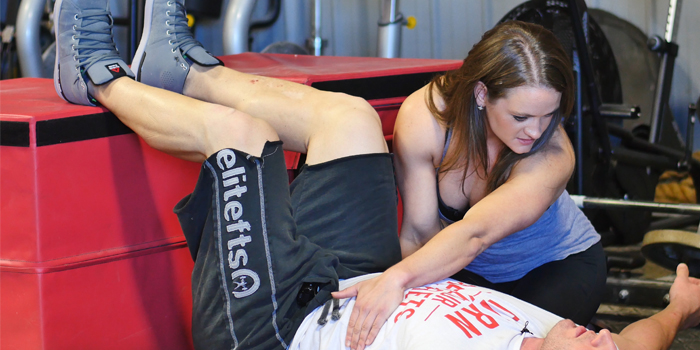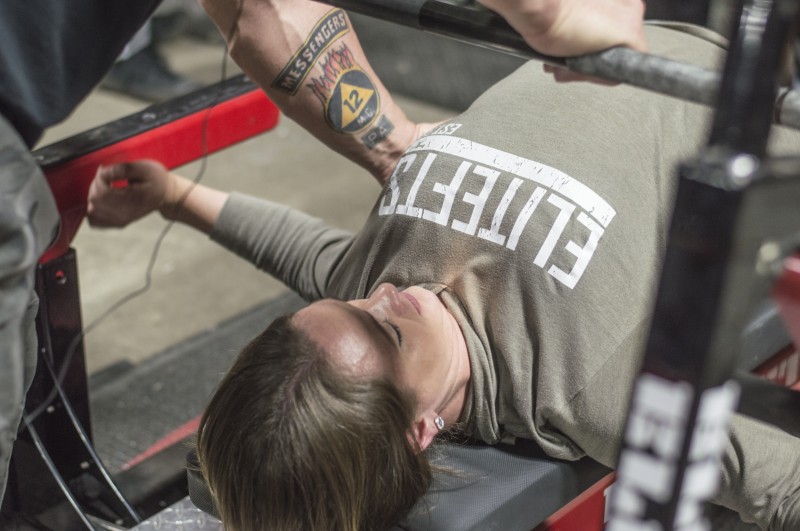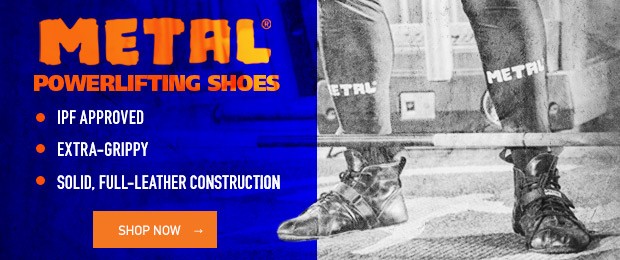
I had a call with Dr. John Rusin today that made me change my article idea and direction entirely. Dr. Rusin is one of the PT’s in the strength and conditioning community that I look up to the most; he’s constantly anticipating tomorrow’s needs today and speaks with the conviction of someone who deeply believes in his knowledge. His character aligns completely with what you would expect given his voice on social media: motivating, humble, driven, and hungry to feed those that want to learn.
I’ve made some big changes lately and felt a little unsure of where to go next or how to accomplish it. I love my clinical work, but I also love this community with my whole heart and care so deeply about it. I’ve always felt “unqualified” to really start putting content out there until I’m never, ever injured again and move perfectly. I laughed as I told him, “But with the way I train—long-ingrained patterns with a lot of strength and preexisting 'stuff'—I don’t think that will ever happen.”
Dr. Rusin said something that struck a chord with me: "The best information comes from necessity.”
RECENT: I Can’t Touch A Barbell Without Hurting: Train or Take Time Off?
Yes. My body has been a mess for so long. I’ve gotten really, really good at training around nearly bionic ankles and a low back that has had issues as far back as I can remember, through multiple sports. Adaptations have always been out of necessity. Your head knowledge will only take you so far; living it and feeling it is where information synthesizes and dots connect. I take a lot of pride in saying this: When it comes to training, I am one of you. I’m not some faraway PT in the magical land of “I’ve never actually touched a barbell in my life and have no desire to constantly get better.”
No. If I’m on that platform or getting ready for it, I want more, just like you.
And it hasn’t been “smart,” but I also know that when iron athletes are training, we aren’t always “smart.” It has given me eyes that otherwise I wouldn’t have, and I feel an overwhelming compulsion to give that back to you from the duality of an elite-level lifter and PT. My necessity has left me with a lot of learning.
2016 was a big year for me in looking at the relationship of necessity and adaptation. It was my first year of clinical practice (which anyone will tell you is internal chaos), I had a great meet at RUM9, a not-so-great one at BOB3, and a lot of “stuff” in between that has all been put away in my brain as pearls to learn from.
- Do your unilateral work and pay attention to it. Really, take 10 minutes at the end of your session and step outside of your “do x reps x sets x tempo x whatever else you look at" and actually stop and ask yourself what things feel like and if you actually feel what you’re intending to with the exercise. The biggest benefit to doing this, aside from the obvious training adaptations, is that you may be able to prevent an injury from getting bad enough to keep you out of training by noticing when and if things feel “off.” Casey is a fantastic example of this. We worked together to clear up some of his issues and he excelled, but when we stopped working together formally, he could feel when and if things started to rile back up again. He has been self-sufficient in addressing it because he knows what he’s looking for. Take this time to find and address small issues before they become something more serious.
- Don’t quit your rehab when you feel good. If you’ve self-designed your program or aren’t working with a professional, give yourself some time to transition and spend some time at least one to two training sessions a week to intentionally continue with what you’ve been doing. Even if you’re feeling good enough to start getting under a bar, chances are you’ll probably have some weird mechanics going on that contributed to why your injury occurred, to begin with. Slowly taper off things, looking to modulate frequency and volume of rehab work. You shouldn’t always have to do it, but going cold turkey is a good way to end up back where you started, and no one has the time or patience for that.
- Your training partners leave you with a choice. If they’re good, they bring you up. Use it. If they bring you down, change your situation, or get mentally tough enough to get that to stop. Stress and distraction mean increased injury risk. You either elevate or dampen your environment, for yourself and those around you. Hold yourself accountable. I am ultra sensitive to people’s moods, but I spent a good portion of 2016 wondering if training was going to be an emotional wreck and exhausting, or if it was going to be a good day based on someone else’s mood. Part of that is on me, but there comes a point where you shouldn’t have to spend extra energy talking yourself out of someone else’s negativity. If you aren’t focused under the bar, it is much more likely you’ll end up hurt. Minimize that chance.
- There is absolutely nothing wrong or shameful about pulling out of a meet. Take the time to explore your reasons, and reach out to someone with competition experience (or one of us on the team — we love hearing from you, it makes our day). I hate to say it, but no one else really notices, and that’s okay. We build up “meet day” in our mind so much, but with the way the sport is growing, it isn’t hard to find a way to use your training cycle to your benefit, especially if you’re feeling more than the normal pre-meet wear and tear. I wish I’d taken my own advice here. Stubbornness and pride got me through a meet but put me in a position where I couldn’t touch over 135 for the next 10 weeks.
- Stress, sleep, and recovery matter. I think this is what it came down to at Boss of Bosses for me this year; it was the complete inverse of RUM9. Stress was high, support was low, and rest (physically and mentally) was very low. At one point in Casey’s rehab, Dave sent us both an email regarding what he suggested for Casey, and I remember very, very vividly an emphasis on uninterrupted sleep. He mentioned things like getting rid of anything lit, like an alarm clock or computer, turning off electronics long before bed, stopping water intake a few hours before, and hanging blackout shades. Don’t roll your eyes and skip this; there is so much that can be said regarding rehab, prevention, and stress reduction on a chemical level.
- Give yourself time to really feel better depending on what tissue is injured. Talk with a healthcare professional, but depending on what’s actually hurt, it’s going to require different healing time. Trust me on this one — it isn’t worth the rush. We hear this a lot, but seriously, your strength isn’t going to just disappear. It will come back, and there is so much beneficial work you can do in the meantime to do things like improving overall stability, which will give you more pounds on the bar in the long-term.
- Either get creative or spend the time doing frilly things you think powerlifters "don't do." Janis Finkelman is an awesome example of being creative; check out how she kept training through a bicep tendon tear repair. Dr. Rusin has been my favorite resource for that this year. Take the time to do something to get better. There’s more to be said for submaximal weight and non-barbell related movements than we give credit to. I see more of us that can’t master submaximal basic movements—like a proper hinge and pull or anti-rotation activities—than you’d think. Can you squat 250% of your bodyweight but cannot demonstrate sufficient motor control in something other than the sagittal plane? You’ve lost your ability to “human” there. Take time to get it back. You will see HUGE benefits.
- Leadership. I’ve always been kind of into leadership theory and different studies, but since moving to Kansas City and training with JP Price and his team, it’s been amazing to see the way he can pull people together in unity to be invested in one another. What’s been incredibly powerful is seeing how aware he is of his giftings and how he’s intentionally utilized that knowledge to create an environment that challenges us, unites us, and supports us on both the great and not-so-great days. I’ve been fortunate lately to be surrounded by people that lead selflessly, and seeing what that does for the training atmosphere is incredible. If you are someone who is remotely gifted in this, challenge yourself to intentionally, humbly, and with service use that gift to create that kind of magic. Whoever you are, to some degree you will have influence in your training environment based on how you are gifted. You have something. Everyone does. If you want to train hard, you know how much better that goes when you’re in a place that you feel enabled to focus, rather than distracted and unsupported. As much as we each crave that, I challenge you to be that. I think truthfully this has been the biggest, most encouraging thing for me to experience the last few months. I can’t wait to go through meet prep with this team.
- Do not constantly flare up your pain and “light up” your attention to it. Remove any perception of threat. It’s one of those things you know in your gut — that visceral “yes” or “no.” Ask yourself, "Does this activity bother my injury?" If you have to use qualifiers (sometimes, but only if, on a full moon, on the third week, on the third year of the unicorn, etc.,), it indicates a threat. Move on for now.
- The best part of this sport is hardly ever the PR or the record. Do not get caught up in that. I did. Hard. And it broke my identity in a way that elicited an incredibly painful season of “growth” I struggled through for a good portion of the year. So much wasted time. From having missed a world record total on a terrible third deadlift call (I will never make the mistake of not knowing what I actually want out of the day ever again), to having an incredibly disappointing performance at the next meet but a day that lead to incredible joy and fullness, I got to feel two extremes in 2016. I know I’ll get another shot at whatever PR I’m chasing. I don’t get another shot at missed conversations, connections with people, learning opportunities, loving and serving opportunities, or savoring that moment. Live that fully. My closest friends have become women across the country who I’ve met in meets, and I’ve grown and learned more about myself through this sport during periods of time that I've looked at everything outside of sheer numbers. That is something I am so proud of. Your numbers will be subject to so many external variables; your character is forged by intentionality.
I hated to do a “pearls of 2016” article, but it was a huge year of learning. I made a lot of mistakes from a rehab as well as a personal standpoint, and really, it can be hard to separate the two. So much of how we train becomes part of our identity that the more reason and order you can have to your “why” you do things, the better. You knew a lot of the things mentioned above already, but you need to know why. Make your decisions with conviction and be patient with them when it comes to rehab and staying healthy. When you aren’t able to train the way you want, you have an incredible opportunity to use that chapter to give somehow. Use it.












Great column with lots to think about.